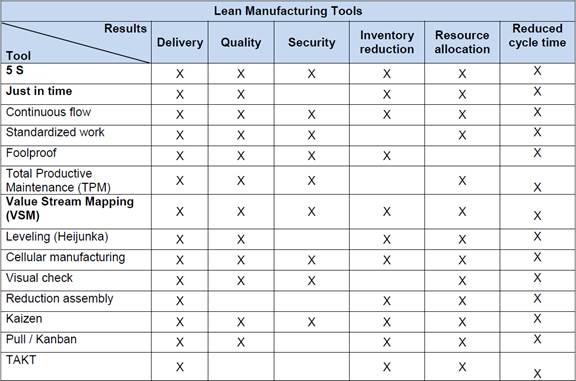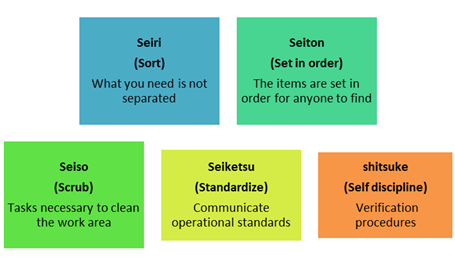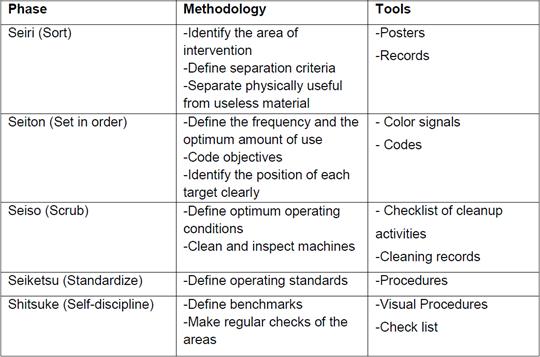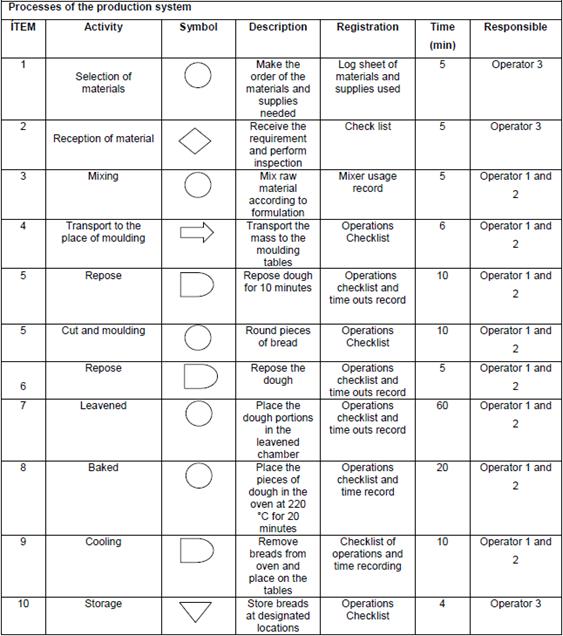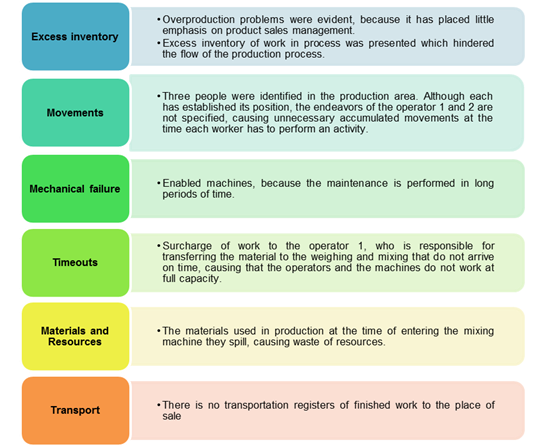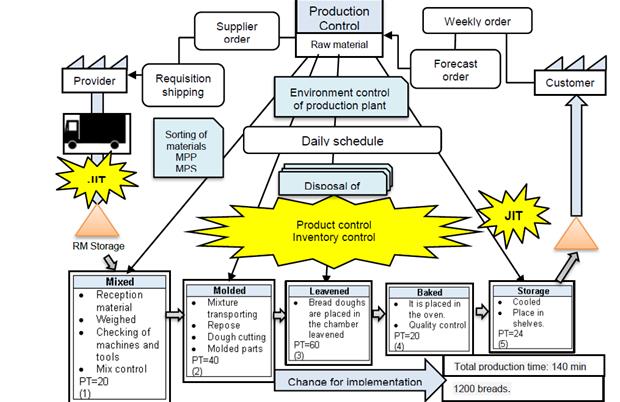1. Introduction
The continuous effort to reduce and eliminate waste leads to maximize productivity, understood as the ability to use rationally and optimally available resources: human, natural, material, financial, scientific and technological involved in the generation of value to provide goods and services that meet the needs of interested parties or stakeholders (Cabrera, 2014).
To measure productivity should relate the units produced with the inputs used for a specific type of work. Every system is perfectible so it is possible to increase productivity; for this purpose it can be reduced the resources used while maintaining the same output, another scenario is increasing outputs while resources remain constant. It is important to say that there can be a combination of both approaches (Fernández, 2010).
Lean manufacturing had its inception in Japan after World War II. Taichii Ohno and Shigeo Shingo developed a new production system for the car company Toyota, this unified system of high productivity and superior quality was known as the Toyota Production System (Krajewsky, Ritzman, & Malhotra, 2008).
In 1990, James Womack published a book called "the machine that changed the world", here the phrase "lean manufacturing" was mentioned as the first time, since then, the concept has been universally accepted (Dailey, 2004) . The adoption of Lean practices has been spread in industries at all levels (Galindo & Villasenor, 2011).
The main objective of lean manufacturing is the implementation of a continuous improvement philosophy that allows organizations to reduce costs, improve processes and eliminate waste to increase customer satisfaction, improve quality, create more efficient machines and labor without reducing the profit margin. Obviously if there is a high percentage of waste in a production process, there is a great opportunity for improvement (Rajadell & Sánchez, 2010).
The manufacturing enterprise of this research belongs to the food industry, its processes are not standardized and documented, in the production phase was identified the presence of different types of waste that preclude the efficient work and it does not rely on management models that will raise their competitiveness and profitability.
On the other hand there is difficulty in calculating the quantities of raw materials employed and its performance related to the units produced as they do not have records of incoming and outgoing material, this creates ignorance of profits generated and the monetary value that is lost in waste of material and time.
Lack of planning, organization and control of the production system generate waste of resources of all kinds and little use of human talent available (Viteri, 2015).
If this situation continues the company will generate losses due to the low productivity and competitiveness in the sector in which it operates, the implementation of the principles and ideas of the lean manufacturing philosophy contribute to the promotion and practice of efficient and free of waste work at each stage of the production process in order to generate savings of money and higher production and incomes.
2. Materials and Methods
The type of research used was exploratory, since it was necessary to observe the organizational environment and its internal functional structure. Descriptive technique and experimental research was applied to analyze the processes and parts that make up the enterprise; besides it was employed the method analytic / systemic, studying stages of the production system in a holistic way.
The first step was to define the activities carried out within the enterprise and their interrelations , it was identified not only those related to the core operations of the production process but also the strategic and support ones by means of a process map.
It was detailed the activities of the operational processes that transform raw material, these were documented as follows:
Identification of all the activities performed in the process, in the order they are executed.
Verification of human resources involved in each activity.
Determination of the symbolism established for each activity (operation, inspection, transportation, and storage expected).
Measurement and record of process time.
Communication with all interested parts.
Moreover, there are fourteen tools attached to the philosophy of lean manufacturing, to carry out this work it was applied three of them: 5 S, just in time and value stream mapping (VSM), they are presented in Table 1.
The first Lean tool used was 5 S, authored by Hiroyuki Hirano and refers to the creation and maintenance of cleaner work areas, more organized and safer (Cantú, 2011). Encourages group participation of all involved in the process, which improves working environment and productivity (King, 2005). Figure 1 shows the five issues addressed in this paper.
* All tools contribute to cost reduction
5 S methodologies was applied in each of the activities of the transformation of raw materials, and as a reference was taken the procedure performed by Galgano (2004), presented in Table 2.
The next step was the application of just in time, this industrial philosophy was born as a result of the precept to reduce waste of all production processes, from procurement of raw materials to the finished product distribution (Muñoz, 2009). The JIT operation seeks to achieve high-volume production, using minimal inventories, guided by actual demand (Chase, Jacobs, & Aquilano, 2007) is guided.
The JIT philosophy was applied to detect processes that do not add value to the company, through the analysis of the seven types of waste: excess of inventory, unnecessary movements, timeouts, transport, inappropriate processes, defects and overproduction; besides considering the financial performance and human talent.
Lean manufacturing defines precisely the added value to products through the manufacturing process (Kamauff, 2010). The last lean tool used was the value stream mapping (VSM) , which is a highly structured methodology for drawing flowcharts to represent the sequence of activities that an organization performs to meet the customer requirements and includes a dual flow of information and necessary resources translated in cycle times and waits (Martin & Osterling, 2014).
The VSM is a systemic tool that allows seeing the set of all processes that add value, not only helps to identify the waste but the origin. It is a great analysis tool, provides the basis to plan the implementation of lean manufacturing and helps to design how it should behave the entire production flow (Ruíz, 2007).
In order to plot both the current and proposed VSM it was used the corresponding symbols of that method, and it was followed the next procedure of Martin and Osterling (2014):
Icons of supplier, customer and production control were designed and customer requirements were entered.
Production was calculated.
Boxes of processes were added in sequence, from left to right.
Communication arrows were plotted and it was written down methods and frequencies.
The symbols and the number of operators were established.
Sites of inventory and demand levels were determined.
Cycle time of total value added was calculated and the total processing time.
3. Results and Discussion
In a global way through a process map, it could be determined operational processes or called value chain; furthermore the strategic and support processes that take place in the enterprise.
The use of the graph in Figure 2 seeks to highlight the intention to work using process management and focus on the customer who defines the product requirements and on the back the company makes every effort to meet their expectations.
Figure 3 shows a detailed description of the operations involved in the transformation of raw material set at the factory to obtain the finished product, further describes the material and human resources involved in the production process; as well as the runtime and the respective control registers for each operation.
After defining the various processes of the production system, culture 5 S was established, the results obtained after implementation were the next:
Sort: signs and posters were designed to place the tools used in the production area. Thanks to this it was possible to identify several objects that are not used and others that needed to be placed in a suitable location.
Set in order: all the elements of production were organized and ordered according to codes and delimited areas with different colors.
Scrub: cleaning responsibilities were assigned to the people that work in each area and records that verify compliance of cleaning schedules were designed.
Standardization: each of the processes used to clean and organize each area of production of bread were documented and standardized.
Self-discipline: This item was performed by putting up posters encouraging the personal growth. Motivational talks and training were also developed, where the commitment of each of the workers to the change in mentality was consolidated. Besides responsibilities were assigned and it was implemented an incentive system that rewards compliance.
To implement just in time, various wastes were identified, Figure 4 shows the results obtained.
Towards the end of the process, actions were taken to strengthen the achieved situation after the improvements implemented by acting on the causes of the problems to avoid repetition and through documental control they are registered to standardize the processes.
The preliminary situation of the production system and the proposal to employ principles of Just in Time can be seen in the VSM graphs of Figures 5 and 6 respectively.
Table 3 shows the improved time of 24 minutes in the entire production cycle, after implementing the methodology 5 S and after eliminating all ways of waste and excess of inventory thanks to principles of JIT in the process of transforming raw materials.
When comparing the results after the implementation of lean manufacturing philosophy with the advantages established by Cuatrecasas (2011) in his investigations, the following was obtained:
Reduction of 24 minutes in the production process, by eliminating inventory of work in process, and improvement of organization, allowing greater fluidity in the production cycle and a more technical and shorter schedule for a better control.
Balance durations in each section or process line.
Reduction of absenteeism, thanks to the training proposal.
Reduction of waste of resources during the productive process.
Standardization of procedures.
Determination of cycle times and adaptation to demand.
Elimination of stored materials that do not add value.
All the benefits discussed above in the first three months resulted in process effectiveness, efficient use of resources and consequently an increase in sales. The monetary calculation of benefits after the implementation of lean manufacturing was $ 9,200; it was obtained thanks to savings on the adquisition of raw materials, elimination of work in process inventory, delivery at time and more orders, therefore higher volume of production and sales.
Finally, the cost of implementation of lean manufacturing, which includes staff training, standardization of processes, maintenance of machines and logistics was $ 5,400.
Table 4 shows the cost benefit that weighted estimated costs against the benefits (Horngren, Sundem, & Stratton, 2006). It was obtained by dividing the profits for the total cost of implementing lean methodology; the result of this operation was 1.7 which means that for every dollar invested it was obtained a profit of 70 cents, so that the investment was justified.
By using Lean philosophy, benefits that directly affect the value chain were achieved. Time reduction was effective, staff became more proactive and participatory, and activities that do not add benefits for the company and customers were eliminated, therefore with the implementation of the lean manufacturing culture the company is competitive in the long term.
4. Conclusions and Recommendations
4.1. Conclusions
The Lean tools can be adopted and configured to every kind of business according to their needs. They are not only techniques used in large enterprises, but also can be applied to micro and small enterprises with favorable economic results.
By applying Lean and eliminating different types of waste could get a reduction of 24 minutes in the total production cycle.
Lean production promotes the full potential, abilities, skills and commitment of human talent in the company, at the same time reaffirms the necessity of working by processes and focus on customer.
The implementation of lean manufacturing cost the company $ 5,400 while profit was $ 9,200, therefore it is possible to say that for every dollar that the company spent on implementing Lean methodology generated a return of $ 0.70.
4.2. Recommendations
It is recommended to use quality management models based on international standards. It is also advised to incorporate statistical tools for production control.
Generate training programs for members of the organization, so that versatility is obtained, that is to say staff is trained to perform different tasks; this will contribute to the flexibility of the system and promote higher levels of participation and motivation.
Maintain commitment and ongoing involvement of high direction in terms of continuous improvement, so that participative leadership is established by using the principles of Lean Manufacturing.













